Abstract
Infection of infants and children with parainfluenza viruses can lead to serious lower respiratory tract disease. In order to review new information on the genetic organization, epidemiology, and immunobiology of these viruses and of respiratory syncytial virus, WHO, in conjunction with the National Institute of Allergy and Infectious Diseases, held a workshop in Bethesda, MD, USA, 4-5 May 1987. New data on the immunobiology and epidemiology of human parainfluenza 3 virus were presented that should facilitate the development of a vaccine against this pathogen.
Full text
PDF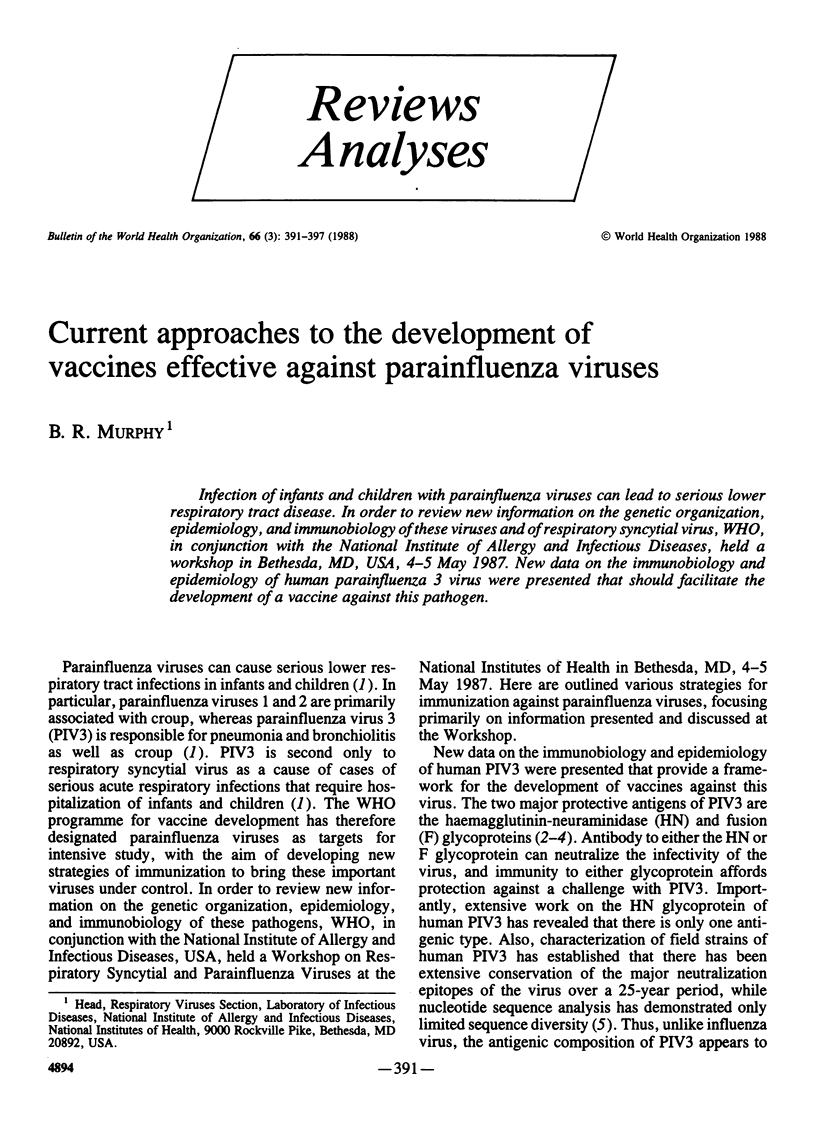
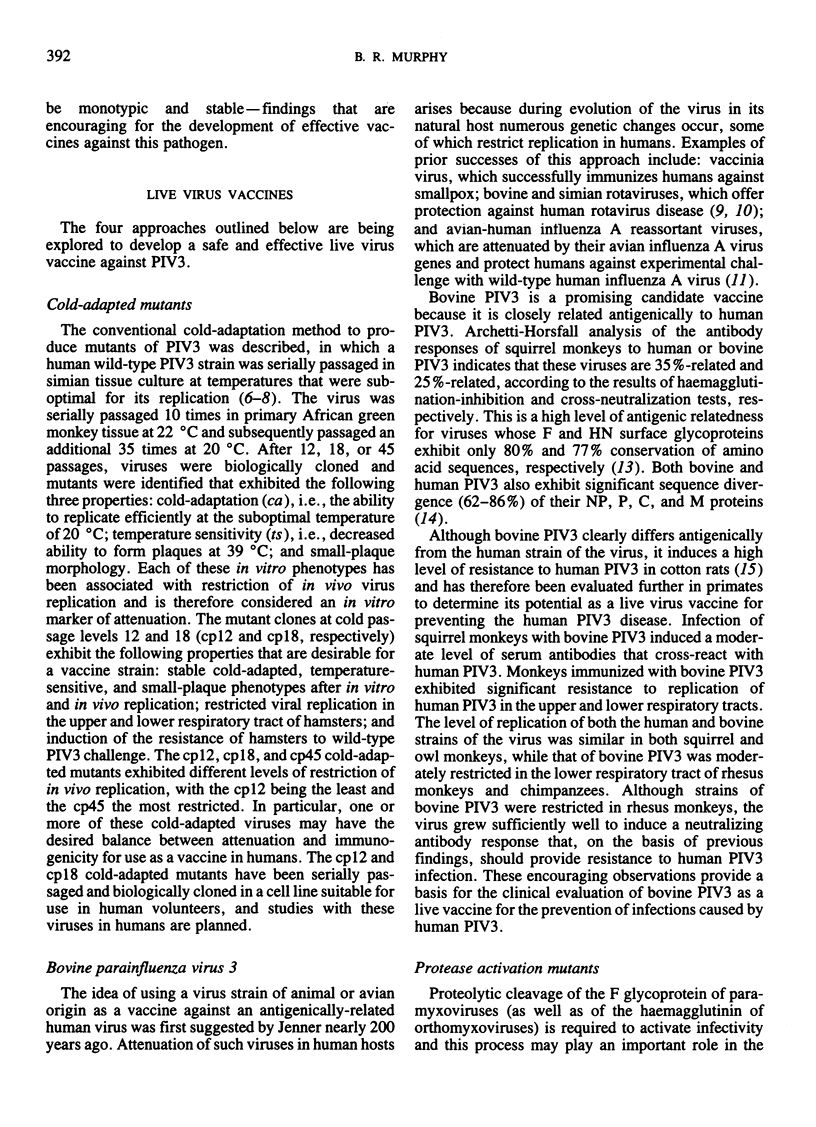
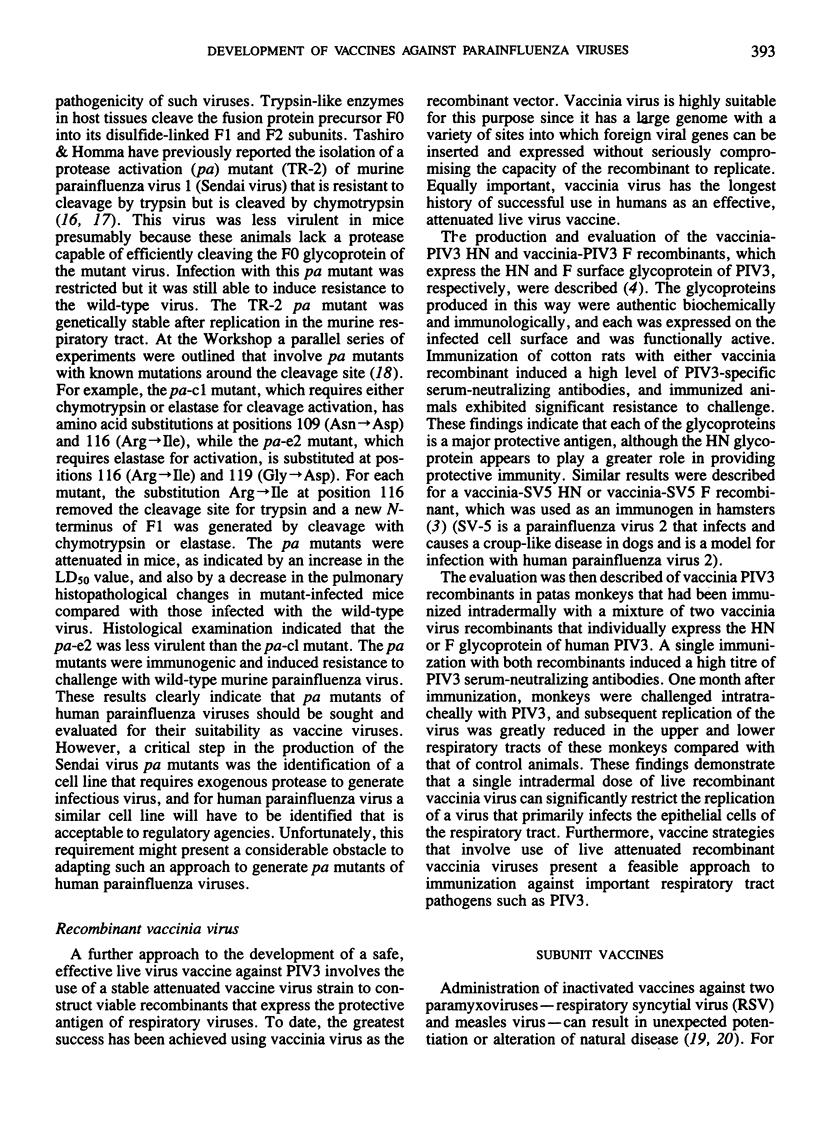
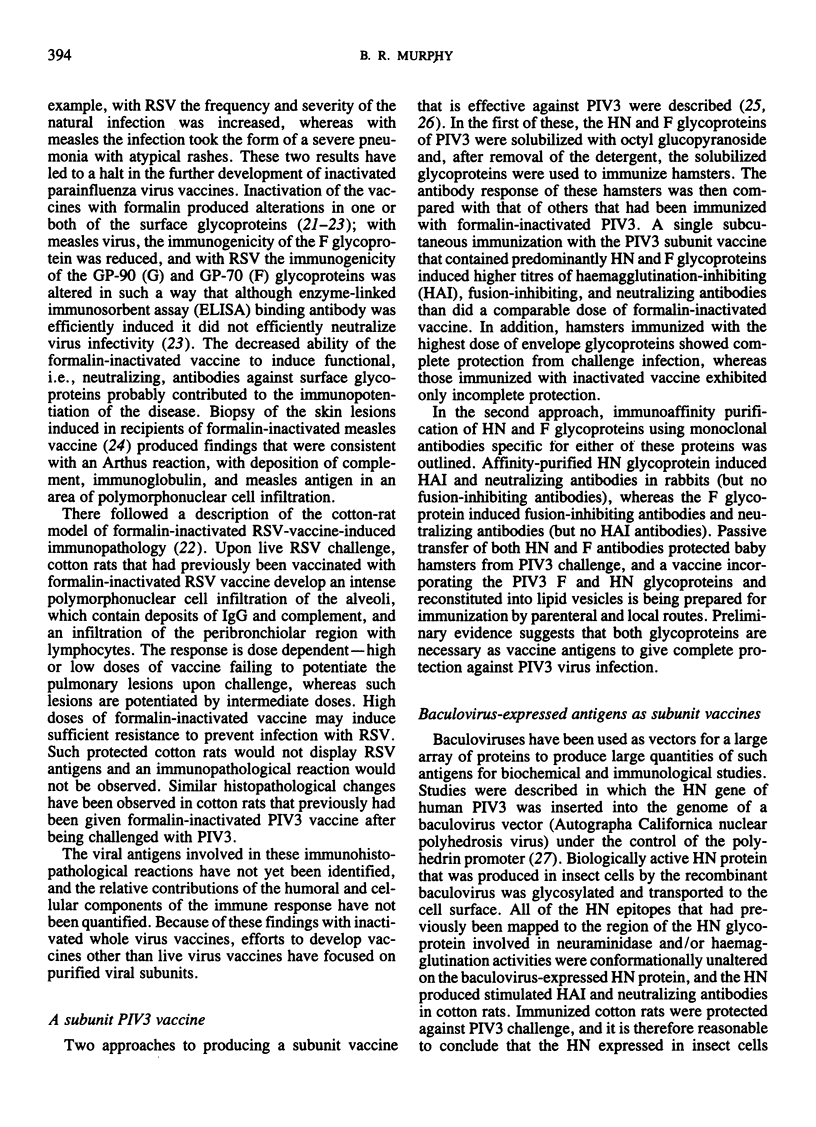


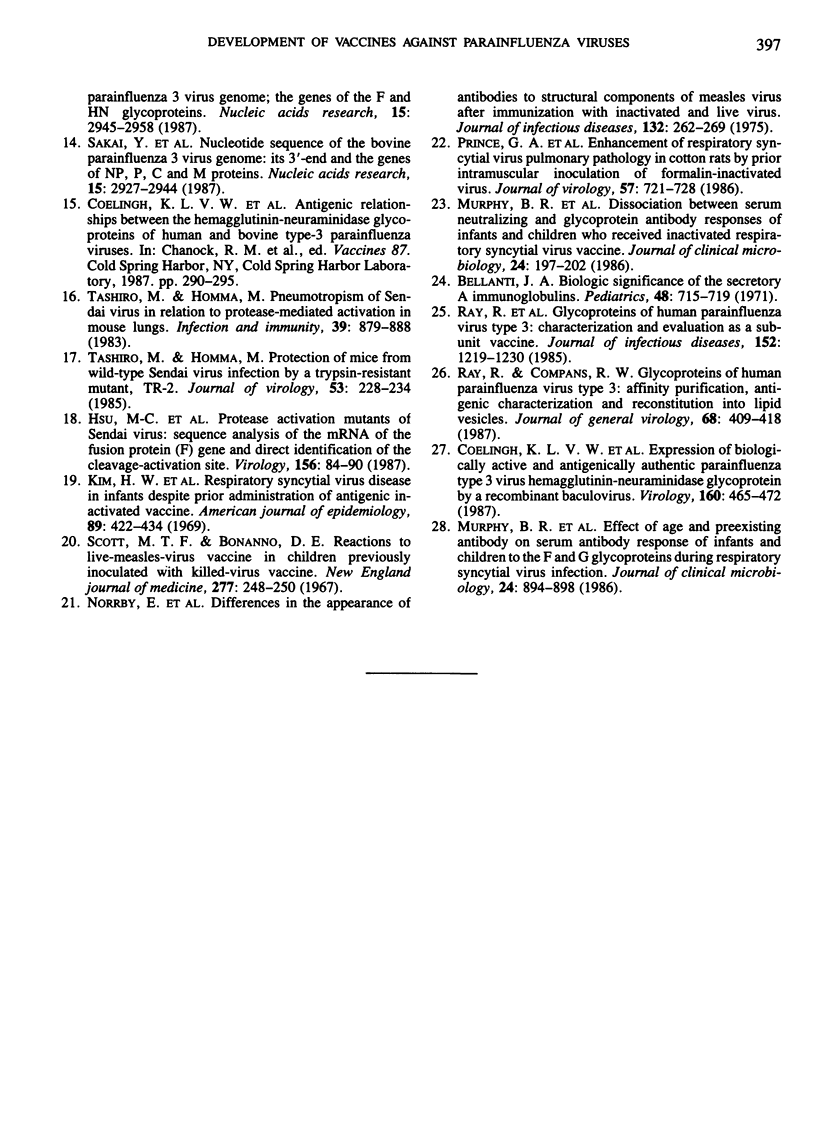
Selected References
These references are in PubMed. This may not be the complete list of references from this article.
- ARCHETTI I., HORSFALL F. L., Jr Persistent antigenic variation of influenza A viruses after incomplete neutralization in ovo with heterologous immune serum. J Exp Med. 1950 Nov 1;92(5):441–462. doi: 10.1084/jem.92.5.441. [DOI] [PMC free article] [PubMed] [Google Scholar]
- Bellanti J. A. Biologic significance of the secretory A immunoglobulins. Pediatrics. 1971 Nov;48(5):715–729. [PubMed] [Google Scholar]
- Belshe R. B., Hissom F. K. Cold adaptation of parainfluenza virus type 3: induction of three phenotypic markers. J Med Virol. 1982;10(4):235–242. doi: 10.1002/jmv.1890100403. [DOI] [PubMed] [Google Scholar]
- Chanock R. M., Mufson M. A., Johnson K. M. Comparative biology and ecology of human virus and Mycoplasma respiratory pathogens. Prog Med Virol. 1965;7:208–252. [PubMed] [Google Scholar]
- Crookshanks-Newman F. K., Belshe R. B. Protection of weanling hamsters from experimental infection with wild-type parainfluenza virus type 3 (para 3) by cold-adapted mutants of para 3. J Med Virol. 1986 Feb;18(2):131–137. doi: 10.1002/jmv.1890180205. [DOI] [PubMed] [Google Scholar]
- Crookshanks F. K., Belshe R. B. Evaluation of cold-adapted and temperature-sensitive mutants of parainfluenza virus type 3 in weanling hamsters. J Med Virol. 1984;13(3):243–249. doi: 10.1002/jmv.1890130306. [DOI] [PubMed] [Google Scholar]
- Flores J., Perez-Schael I., Gonzalez M., Garcia D., Perez M., Daoud N., Cunto W., Chanock R. M., Kapikian A. Z. Protection against severe rotavirus diarrhoea by rhesus rotavirus vaccine in Venezuelan infants. Lancet. 1987 Apr 18;1(8538):882–884. doi: 10.1016/s0140-6736(87)92858-3. [DOI] [PubMed] [Google Scholar]
- Hsu M. C., Scheid A., Choppin P. W. Protease activation mutants of Sendai virus: sequence analysis of the mRNA of the fusion protein (F) gene and direct identification of the cleavage-activation site. Virology. 1987 Jan;156(1):84–90. doi: 10.1016/0042-6822(87)90438-7. [DOI] [PubMed] [Google Scholar]
- Kim H. W., Canchola J. G., Brandt C. D., Pyles G., Chanock R. M., Jensen K., Parrott R. H. Respiratory syncytial virus disease in infants despite prior administration of antigenic inactivated vaccine. Am J Epidemiol. 1969 Apr;89(4):422–434. doi: 10.1093/oxfordjournals.aje.a120955. [DOI] [PubMed] [Google Scholar]
- Murphy B. R., Alling D. W., Snyder M. H., Walsh E. E., Prince G. A., Chanock R. M., Hemming V. G., Rodriguez W. J., Kim H. W., Graham B. S. Effect of age and preexisting antibody on serum antibody response of infants and children to the F and G glycoproteins during respiratory syncytial virus infection. J Clin Microbiol. 1986 Nov;24(5):894–898. doi: 10.1128/jcm.24.5.894-898.1986. [DOI] [PMC free article] [PubMed] [Google Scholar]
- Murphy B. R., Clements M. L., Tierney E. L., Black R. E., Stienberg J., Chanock R. M. Dose response of influenza A/Washington/897/80 (H3N2) avian-human reassortant virus in adult volunteers. J Infect Dis. 1985 Jul;152(1):225–229. doi: 10.1093/infdis/152.1.225. [DOI] [PubMed] [Google Scholar]
- Murphy B. R., Prince G. A., Walsh E. E., Kim H. W., Parrott R. H., Hemming V. G., Rodriguez W. J., Chanock R. M. Dissociation between serum neutralizing and glycoprotein antibody responses of infants and children who received inactivated respiratory syncytial virus vaccine. J Clin Microbiol. 1986 Aug;24(2):197–202. doi: 10.1128/jcm.24.2.197-202.1986. [DOI] [PMC free article] [PubMed] [Google Scholar]
- Norrby E., Enders-Ruckle G., Meulen V. Differences in the appearance of antibodies to structural components of measles virus after immunization with inactivated and live virus. J Infect Dis. 1975 Sep;132(3):262–269. doi: 10.1093/infdis/132.3.262. [DOI] [PubMed] [Google Scholar]
- Orvell C., Grandien M. The effects of monoclonal antibodies on biologic activities of structural proteins of Sendai virus. J Immunol. 1982 Dec;129(6):2779–2787. [PubMed] [Google Scholar]
- Paterson R. G., Lamb R. A., Moss B., Murphy B. R. Comparison of the relative roles of the F and HN surface glycoproteins of the paramyxovirus simian virus 5 in inducing protective immunity. J Virol. 1987 Jun;61(6):1972–1977. doi: 10.1128/jvi.61.6.1972-1977.1987. [DOI] [PMC free article] [PubMed] [Google Scholar]
- Prince G. A., Jenson A. B., Hemming V. G., Murphy B. R., Walsh E. E., Horswood R. L., Chanock R. M. Enhancement of respiratory syncytial virus pulmonary pathology in cotton rats by prior intramuscular inoculation of formalin-inactiva ted virus. J Virol. 1986 Mar;57(3):721–728. doi: 10.1128/jvi.57.3.721-728.1986. [DOI] [PMC free article] [PubMed] [Google Scholar]
- Ray R., Brown V. E., Compans R. W. Glycoproteins of human parainfluenza virus type 3: characterization and evaluation as a subunit vaccine. J Infect Dis. 1985 Dec;152(6):1219–1230. doi: 10.1093/infdis/152.6.1219. [DOI] [PubMed] [Google Scholar]
- Ray R., Compans R. W. Glycoproteins of human parainfluenza virus type 3: affinity purification, antigenic characterization and reconstitution into lipid vesicles. J Gen Virol. 1987 Feb;68(Pt 2):409–418. doi: 10.1099/0022-1317-68-2-409. [DOI] [PubMed] [Google Scholar]
- Scott T. F., Bonanno D. E. Reactions to live-measles-virus vaccine in children previously inoculated with killed-virus vaccine. N Engl J Med. 1967 Aug 3;277(5):248–250. doi: 10.1056/NEJM196708032770506. [DOI] [PubMed] [Google Scholar]
- Spriggs M. K., Murphy B. R., Prince G. A., Olmsted R. A., Collins P. L. Expression of the F and HN glycoproteins of human parainfluenza virus type 3 by recombinant vaccinia viruses: contributions of the individual proteins to host immunity. J Virol. 1987 Nov;61(11):3416–3423. doi: 10.1128/jvi.61.11.3416-3423.1987. [DOI] [PMC free article] [PubMed] [Google Scholar]
- Tashiro M., Homma M. Pneumotropism of Sendai virus in relation to protease-mediated activation in mouse lungs. Infect Immun. 1983 Feb;39(2):879–888. doi: 10.1128/iai.39.2.879-888.1983. [DOI] [PMC free article] [PubMed] [Google Scholar]
- Tashiro M., Homma M. Protection of mice from wild-type Sendai virus infection by a trypsin-resistant mutant, TR-2. J Virol. 1985 Jan;53(1):228–234. doi: 10.1128/jvi.53.1.228-234.1985. [DOI] [PMC free article] [PubMed] [Google Scholar]
- van Wyke Coelingh K. L., Murphy B. R., Collins P. L., Lebacq-Verheyden A. M., Battey J. F. Expression of biologically active and antigenically authentic parainfluenza type 3 virus hemagglutinin-neuraminidase glycoprotein by a recombinant baculovirus. Virology. 1987 Oct;160(2):465–472. doi: 10.1016/0042-6822(87)90018-3. [DOI] [PubMed] [Google Scholar]
- van Wyke Coelingh K. L., Winter C., Murphy B. R. Antigenic variation in the hemagglutinin-neuraminidase protein of human parainfluenza type 3 virus. Virology. 1985 Jun;143(2):569–582. doi: 10.1016/0042-6822(85)90395-2. [DOI] [PubMed] [Google Scholar]


